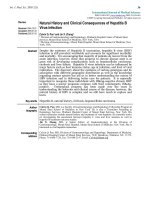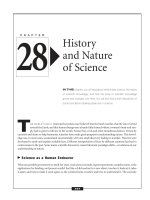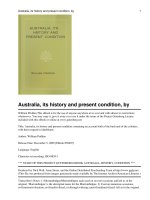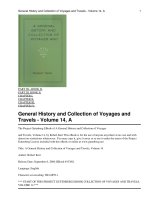Film History and Criticism II 3_0
Bạn đang xem bản rút gọn của tài liệu. Xem và tải ngay bản đầy đủ của tài liệu tại đây (1.6 MB, 51 trang )
Film History and Criticism
lecture 3
Italian Neo-Realism (1944-49)
Week 3, January 22nd
Italian Neorealism:
Readings: Thompson & Bordwell Chapter 16 Neorealism and its
Context pp.330-341 and Visconti, Rossellini Box, p338
Supplementary Readings: Hayward, S. Key Concepts: Italian NeoRealism pp.191-2.
Corrigan, Timothy, White, Patricia, with Meta Mazaj, Critical Visions
in Film Theory; Classical and Contemporary Readings Part 3
Modernism and Realism: Debates in Classical Film Theory. Andre
Bazin “The Evolution of the Language of Cinema” pp 309-325 &
Cesare Zavattini “Some ideas on the Cinema pp 915 -924
Screening: Rome, Open City (Roberto Rossellini dir. 1945) and clips
from Miraculo a Milano (Miracle in Milan) (1950) and Ladri di
Biciclette (Bicycle Thieves, 1948) dir. Vittorio De Sica.
www.robertorossellini.it/ official site
Introduction
Key Questions:
• When did it begin and end?
• What were its sources?
• Characteristics?
• Was it new/neo?
• How Italian was it?
• How realistic?
Responses
1. Term as a movement closely tied to the
social-political situation in post-war Italy.
Neo-realism coined by Italian Critic
Umberto Barbaro.
2. French poetic realism Marcel Carne’s late
films: Port of Shadows (1938) Daybreak
(1939) and Jean Renoir, Rules of the
Game (1939), and Grand Illusion (1937).
3. Characteristics of neo-Realism
a)
b)
c)
d)
e)
Location shooting
Post-synchronized sound shooting
Use of non-professional actors
Not interested in entertainment
A commitment to representation of social
reality/actuality
f) The narrative reflects actual duration
g) Racked focus and long takes c.w. Renoir
4. Major Figures
Roberto Rossellini (1906-1977) Rome Open City,
(1945); Paisan (1946) , Germany Year Zero
(1947).
Vittorio De Sica (1902-1974) and Script writer
Cersare Zavattini (1902-1989) Shoeshine, Bicycle
Thieves, Miracle in Milan and Umberto D (1952)
Luchiano Visconti (1906) Ossessione (Obsession
1942), The Earth Trembles (1948)
Guiseppe de Santis (b1917) Riso Amaro (Bitter Rice
1949) Tragic Hunt (1948), No Peace for Under the
Olives (1950)
Characteristics continued
5. Was it New as the term Neo suggests – yes and
no for the reasons cited earlier.
6. How Italian? Very, although there are also
similar elements in earlier French cinema within
poetic realist films.
7. How realist? With emphasis on location
shooting more so than studio cinema.
8. To the Italian neo-Realists, reality and truth are
not the same: reality (considered that which is
possible to observe in everyday life) is the way
to truth, and truth is the set of production
relationships that rules society - the Marxist
inspiration is evident here.
Roberto Rossellini
b. May 8, 1906, -d. June 3, 1977, Rome, Italy.
“The father of neo-realism”
•
Biographical details:
Roberto Rossellini was born in Rome May 8, 1906 the
eldest son of a prominent Italian architect, had a younger
brother named Renzo and sisters Marcela and Micaela.
By all accounts Roberto lived a fairly stable life in a
bourgeois – middle class home which enabled him to
secure a good education and prospects for a career.
General Guide to his films:
1) The Fascist period (1941-1944): Being 16 when Mussolini
took power, Rossellini's formative period as a film maker was
under fascism. He started his directorial career with three
fascist propaganda features: La nave bianca (The White
Ship) (1941) Un piloto ritorna (A Pilot Returns) (1942)
L'uomo della crocce (The Man with the Cross) (1943)
2) Postwar trilogy (1945-1947): Only two years after his last
fascist feature, Rossellini completed Roma, città aperta
(1945), one of the most important - and immediate antifascist films, considered by many the beginning of Italian
neo-Realism. This direction was emphasized in his following
Paisà (1946) and Germania, anno zero (1947), is considered
the most powerful anti-war film of his trilogy.
Paisà1946
Germany Year Zero 1947
3) His 'Modern' film period (1949-1954): Stromboli
(1949), a period is marked by his marriage to Ingrid
Bergman and her participation in his work.
4.) Disenchantment (1957-1962): After his divorce from
Ingrid
Bergman, Rossellini traveled to India in 1957,
where he completed a ten-part documentary series on
16mm. for Italian television and a 90-minute 35mm.
feature. Later he began a four year period producing
war films, and he also began exhibiting
disenchantment with cinema.
Cultural history (1964-1977):
5. In 1963, Rossellini abandoned cinema to work in
television. He directed nine telefilms on historical
subjects and six short documentaries, claiming TV
could be used as an educational device. Near the end
of these years, he completed two biographical
features - Anno uno (1974), about Alcide de Gasperi,
a Christian democrat politician and first postwar
Italian president, and Il messiah (1975). Both were
very badly received by Italian society, and Rossellini
- who claimed they were within the realm of his
history project pursued thus far on television - was
accused of being reactionary and selling out.
Rossellini's films are as much documentaries as they
are fiction.
Roma, città aperta (1945) is based on a narrative
focusing upon three martyrs of the second world
war. As Rossellini had few resources the film was
shot on the actual locations, using different film
stocks, in conditions that made lighting difficult,
thus providing a documentary visual style. This,
added to the colloquial dialogue, and very
naturalistic acting, represented the core of this new
"style" - Italian neo-Realism. The national and
international success of the film earned Rossellini
the title of "father of neo-Realism".
Roma, città aperta differs from the neo-realist
corpus (even from Rossellini's Paisà, his closest to
neo-Realism) in significant ways. One of them, not
the most important though, is the use of professional
actors in the leading roles









